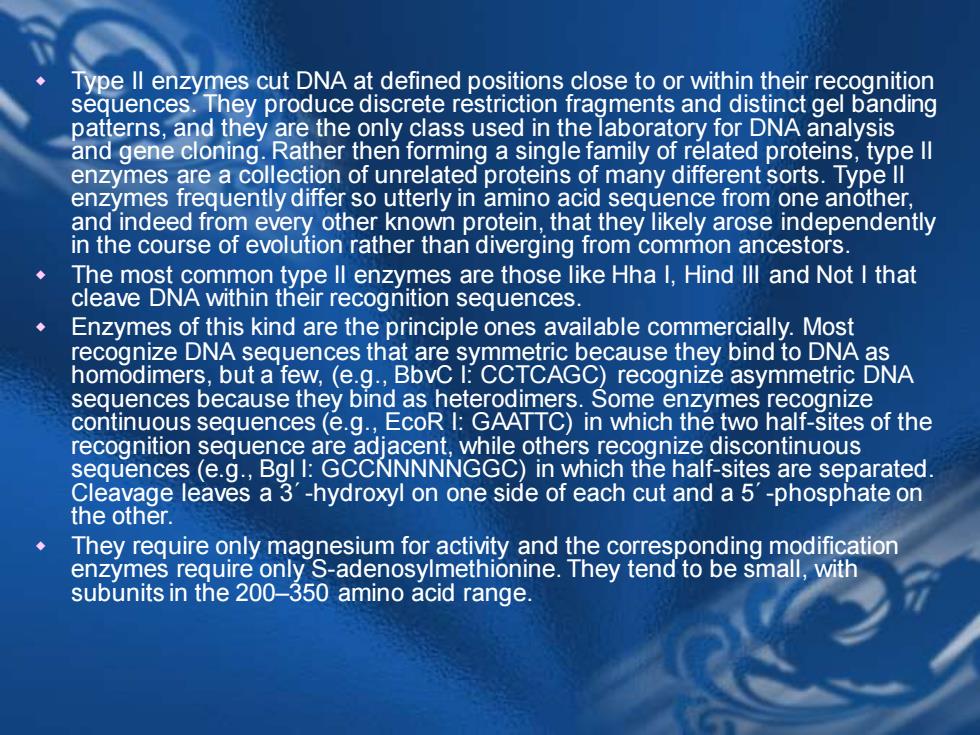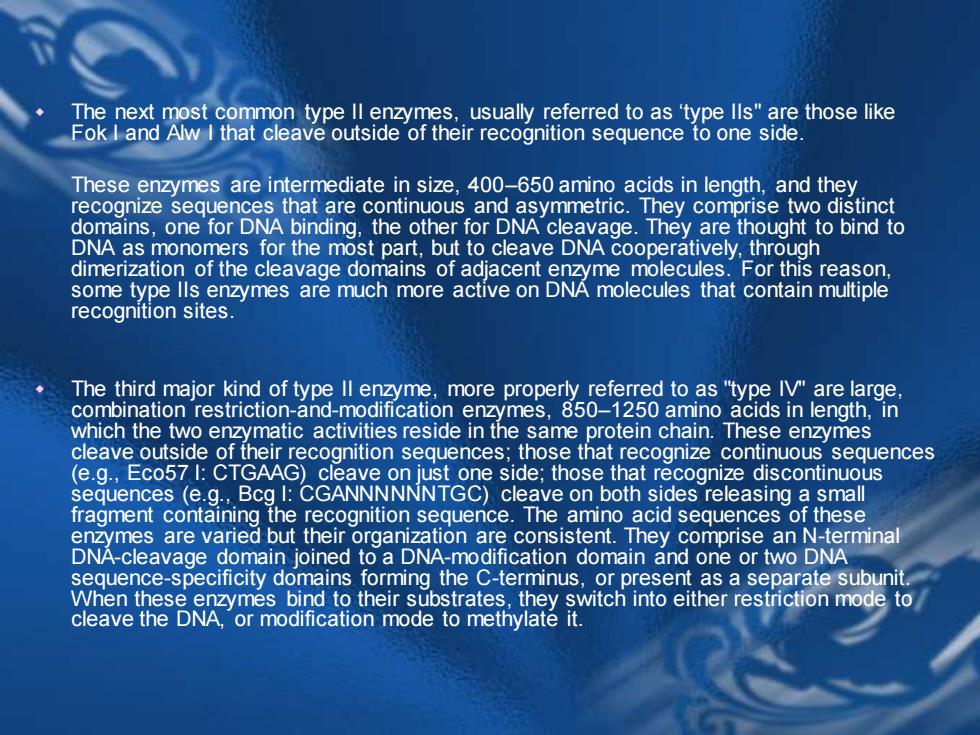
Type II enzymes cut DNA at defined positions close to or within their recognition sequences. They produce discrete restriction fragments and distinct gel banding patterns, and they are the only class used in the laboratory for DNA analysis and gene cloning. Rather then forming a single family of related proteins, type II enzymes are a collection of unrelated proteins of many different sorts. Type II enzymes frequently differ so utterly in amino acid sequence from one another, and indeed from every other known protein, that they likely arose independently in the course of evolution rather than diverging from common ancestors. The most common type II enzymes are those like Hha I, Hind III and Not I that cleave DNA within their recognition sequences. Enzymes of this kind are the principle ones available commercially. Most recognize DNA sequences that are symmetric because they bind to DNA as homodimers, but a few, (e.g., BbvC I: CCTCAGC) recognize asymmetric DNA sequences because they bind as heterodimers. Some enzymes recognize continuous sequences (e.g., EcoR I: GAATTC) in which the two half-sites of the recognition sequence are adjacent, while others recognize discontinuous sequences (e.g., Bgl I: GCCNNNNNGGC) in which the half-sites are separated. Cleavage leaves a 3´-hydroxyl on one side of each cut and a 5´-phosphate on the other. They require only magnesium for activity and the corresponding modification enzymes require only S-adenosylmethionine. They tend to be small, with subunits in the 200–350 amino acid range
Type II enzymes cut DNA at defined positions close to or within their recognition sequences. They produce discrete restriction fragments and distinct gel banding patterns, and they are the only class used in the laboratory for DNA analysis and gene cloning. Rather then forming a single family of related proteins, type II enzymes are a collection of unrelated proteins of many different sorts. Type II enzymes frequently differ so utterly in amino acid sequence from one another, and indeed from every other known protein, that they likely arose independently in the course of evolution rather than diverging from common ancestors. The most common type II enzymes are those like Hha I, Hind III and Not I that cleave DNA within their recognition sequences. Enzymes of this kind are the principle ones available commercially. Most recognize DNA sequences that are symmetric because they bind to DNA as homodimers, but a few, (e.g., BbvC I: CCTCAGC) recognize asymmetric DNA sequences because they bind as heterodimers. Some enzymes recognize continuous sequences (e.g., EcoR I: GAATTC) in which the two half-sites of the recognition sequence are adjacent, while others recognize discontinuous sequences (e.g., Bgl I: GCCNNNNNGGC) in which the half-sites are separated. Cleavage leaves a 3´-hydroxyl on one side of each cut and a 5´-phosphate on the other. They require only magnesium for activity and the corresponding modification enzymes require only S-adenosylmethionine. They tend to be small, with subunits in the 200–350 amino acid range

The next most common type II enzymes, usually referred to as ‘type IIs" are those like Fok I and Alw I that cleave outside of their recognition sequence to one side. These enzymes are intermediate in size, 400–650 amino acids in length, and they recognize sequences that are continuous and asymmetric. They comprise two distinct domains, one for DNA binding, the other for DNA cleavage. They are thought to bind to DNA as monomers for the most part, but to cleave DNA cooperatively, through dimerization of the cleavage domains of adjacent enzyme molecules. For this reason, some type IIs enzymes are much more active on DNA molecules that contain multiple recognition sites. The third major kind of type II enzyme, more properly referred to as "type IV" are large, combination restriction-and-modification enzymes, 850–1250 amino acids in length, in which the two enzymatic activities reside in the same protein chain. These enzymes cleave outside of their recognition sequences; those that recognize continuous sequences (e.g., Eco57 I: CTGAAG) cleave on just one side; those that recognize discontinuous sequences (e.g., Bcg I: CGANNNNNNTGC) cleave on both sides releasing a small fragment containing the recognition sequence. The amino acid sequences of these enzymes are varied but their organization are consistent. They comprise an N-terminal DNA-cleavage domain joined to a DNA-modification domain and one or two DNA sequence-specificity domains forming the C-terminus, or present as a separate subunit. When these enzymes bind to their substrates, they switch into either restriction mode to cleave the DNA, or modification mode to methylate it
The next most common type II enzymes, usually referred to as ‘type IIs" are those like Fok I and Alw I that cleave outside of their recognition sequence to one side. These enzymes are intermediate in size, 400–650 amino acids in length, and they recognize sequences that are continuous and asymmetric. They comprise two distinct domains, one for DNA binding, the other for DNA cleavage. They are thought to bind to DNA as monomers for the most part, but to cleave DNA cooperatively, through dimerization of the cleavage domains of adjacent enzyme molecules. For this reason, some type IIs enzymes are much more active on DNA molecules that contain multiple recognition sites. The third major kind of type II enzyme, more properly referred to as "type IV" are large, combination restriction-and-modification enzymes, 850–1250 amino acids in length, in which the two enzymatic activities reside in the same protein chain. These enzymes cleave outside of their recognition sequences; those that recognize continuous sequences (e.g., Eco57 I: CTGAAG) cleave on just one side; those that recognize discontinuous sequences (e.g., Bcg I: CGANNNNNNTGC) cleave on both sides releasing a small fragment containing the recognition sequence. The amino acid sequences of these enzymes are varied but their organization are consistent. They comprise an N-terminal DNA-cleavage domain joined to a DNA-modification domain and one or two DNA sequence-specificity domains forming the C-terminus, or present as a separate subunit. When these enzymes bind to their substrates, they switch into either restriction mode to cleave the DNA, or modification mode to methylate it